Occupational environment monitoring at the factory producing cosmetics
99,000 ₫
Note: The above price is calculated for one sample. Prices may fluctuate depending on the area of the environment to be monitored and market conditions. For more accurate pricing support, please refer to the price list or contact our consulting staff directly.
Workplace environment monitoring for a cosmetic production factory is a session of collecting, analyzing, and evaluating factors at the workplace that may be harmful to workers health.
Table of Contents
Toggle1. Overview of Cosmetic Manufacturing Factories
a. What is a cosmetic manufacturing factory?
A manufacturing factory for cosmetics is a facility that produces goods related to beauty and personal care products, including cosmetics, skincare products, hair care, body care, and many other types of products. These factories usually have production lines and specialized equipment to manufacture and package cosmetic products according to specific processes and standards. These stages may vary depending on the type of cosmetic product and the specific production process of each factory.

b. Production stages in a cosmetic manufacturing factory
The production stages in a cosmetic manufacturing factory may include:
- Research and Development: This stage involves researching ingredients, formulas, and new cosmetic production technologies. Experts conduct tests and analyses to develop new products and improve existing ones.
- Raw Material Preparation: Necessary ingredients for cosmetic production, including main components such as oils, thickeners, colorants, fragrances, and other additives, are prepared and mixed according to specific ratios and procedures.
- Production: The cosmetic production process involves combining ingredients and chemical activation stages (if any) to create the final product. Production methods may include mixing, melting, stirring, whipping, and other procedures.
- Packaging: After production, products are packaged in suitable containers such as bottles, jars, tubes, bottles, boxes, etc. Packaging must comply with regulations on storage, safety, and environmental protection.
- Quality Control: Cosmetic products are inspected to ensure compliance with standards and regulations. Quality checks may include factors such as pH, stability, efficacy, safety for use, microbiological quality, performance, and other aspects.
- Sealing and Labeling: After quality control, products are sealed and labeled. Labels contain information on ingredients, usage instructions, manufacturing date, expiration date, and other relevant details.
- Storage and Transportation: After production, cosmetic products are stored in warehouses or factories and prepared for transport to retail points or distributors.

c. Types of machinery used in cosmetic manufacturing factories
In cosmetic manufacturing factories, various types of machinery are used to carry out production stages. Some common machinery in the cosmetic industry includes:
- Mixers: Used to blend ingredients and cosmetic components into a homogeneous mixture with the desired viscosity.
- Sealing Machines: Used to seal containers such as bottles, jars, and tubes to ensure safety and prevent contamination or product loss.
- Packaging Machines: Includes automatic or semi-automatic machines for packaging cosmetic products into containers such as cartons, plastic bags, plastic bottles, glass jars, etc.
- Filling Machines: Used to fill cosmetic products from storage tanks into containers such as bottles, jars, and tubes, ensuring accurate and efficient product volume.
- Labeling Machines: Used to print labels for cosmetic products with information on ingredients, usage instructions, manufacturing date, expiration date, and other details.
- Quality Control Equipment: Includes devices and machinery to inspect the quality of cosmetic products, such as pH meters, viscosity testers, stability testers, microbiological testers, etc.
- Outer Packaging Machines: Includes machinery for outer packaging, such as vacuum sealers, presses, capping machines, labeling machines, etc.
- Cutting, Polishing, and Beautifying Machines: Used to cut, polish, smooth, and enhance cosmetic products such as creams, foundations, lipsticks, etc.

d. Occupational diseases that workers in cosmetic manufacturing factories may face
Workers in cosmetic manufacturing factories may be exposed to certain environmental factors and chemicals that can cause health issues and occupational diseases. Some common occupational diseases that cosmetic industry workers may encounter include:
- Skin Allergies: Exposure to chemical ingredients in cosmetics can cause skin allergies, leading to itching, dermatitis, redness, and flaking.
- Respiratory Problems: Workers may inhale fumes or dust from chemicals during cosmetic production, causing respiratory issues such as pneumonia or difficulty breathing.
- Eye Issues: Exposure to chemicals can cause eye irritation and inflammation.
- Skin Problems: Workers may come into contact with chemical compounds causing skin irritation, dryness, or burns.
- Air Pollution: The production process may release gases and vapors that pollute the workplace air, affecting air quality and respiratory health.
- Chemical Toxicity: Workers may be exposed to toxic chemical compounds such as lead, mercury, formaldehyde, parabens, and other additives that can harm health.
To prevent and reduce the risk of occupational diseases, cosmetic manufacturing factories must comply with occupational safety regulations and provide health protection measures for workers. This includes providing personal protective equipment, safety training, controlling chemical exposure levels, monitoring the work environment, and offering preventive measures.

e. Common cosmetic products on the market
There are many common cosmetic products on the market, including:
- Skin creams: Including moisturizers, sunscreens, whitening creams, anti-aging creams, night creams, and many others.
- Facial cleansers: Including cream cleansers, gel cleansers, whitening cleansers, acne-clearing cleansers, and cleansers for sensitive skin.
- Masks: Various masks such as moisturizing masks, brightening masks, firming masks, anti-aging masks, and other skincare masks.
- Eye shadow and mascara: Includes eye shadow, volumizing and lengthening mascara, smudge-proof mascara, curling mascara, and other types.
- Lipsticks: Various types including lip balms, colored lipsticks, matte, glossy, cream, tints, and others.
- Powders and foundations: Includes oil-control powders, brightening powders, concealing foundations, moisturizing foundations, and other types.
- Hair care products: Includes shampoo, conditioner, hair oil, styling creams, gels, and other hair care products.
- Body care products: Includes shower gels, body creams, moisturizing lotions, hand and foot creams, and other body care products.
2. Overview of occupational environmental monitoring services
a. What is occupational environmental monitoring in a cosmetic manufacturing factory?
Occupational environmental monitoring (or workplace environment measurement) in a cosmetic manufacturing factory involves collecting, evaluating, and analyzing indicators of workplace environmental factors to promptly implement measures that minimize environmental harm to workers’ health and prevent occupational diseases. Occupational environmental monitoring is mandatory for cosmetic manufacturing factories.
Occupational environmental monitoring plays a crucial role in safeguarding, protecting, and improving workers’ health because the main resource of a company, which directly generates profit, is its workforce. Workers who are regularly exposed to hazardous factors exceeding permissible limits are at risk of health impacts and occupational diseases.
REGISTER FOR OCCUPATIONAL ENVIRONMENT MONITORING SERVICE
b. Nam Viet’s occupational environmental monitoring program
Nam Viet’s occupational environmental monitoring program is designed by engineers specializing in occupational safety and environmental protection. With the goal of ensuring workers’ health and safety, the program employs modern measurement methods to monitor air quality, water, microclimate factors, physical factors, dust, and more in the work environment. This program is essential for ensuring a safe working environment and protecting workers’ health.
Additionally, Nam Viet’s program plays an important role in researching and developing new solutions to improve workplace environmental quality. With the dedication and professionalism of its monitoring experts, Nam Viet’s proprietary monitoring program has become a breakthrough in occupational safety and environmental management in Vietnam.

c. Standardization in workplace measurement procedures
Standardization in Nam Viet’s workplace measurement procedures is crucial for ensuring the accuracy and reliability of results. The program follows standards and procedures recognized by the Ho Chi Minh City Department of Health. This ensures that collected data is highly reliable when assessing the work environment and making decisions to improve workplace conditions to protect workers’ health.
These standardized procedures also ensure that measurements are conducted by highly qualified monitoring specialists with years of experience, enabling managers and experts to trust the results from An Toan Nam Viet and make accurate, valuable decisions to safeguard worker health and the environment.
By applying standardization in workplace measurement procedures, Nam Viet demonstrates its commitment to providing a safe working environment and protecting worker health, while contributing to the development and enhancement of occupational safety and environmental management in Vietnam.
d. Reporting results of monitoring in cosmetic manufacturing factories
Occupational environmental monitoring results are prepared according to Form 04, Appendix III, issued with Decree 44/2016/ND-CP and is made in 2 copies: one copy sent to the workplace that signed the monitoring contract, and one copy kept at the monitoring organization.
The retention period for monitoring results is indefinite as per legal regulations.

e. Frequency of occupational environmental monitoring as required by law
According to Clause 2, Article 18 of the Law on Occupational Safety and Hygiene 84/2015/QH13, employers must organize workplace monitoring to assess harmful factors at least once a year.
f. Deadline for submitting occupational environmental monitoring reports as required by law
The deadline for submitting reports is before December 31 each year. Enterprises operating production facilities must submit occupational environmental monitoring reports to the local Department of Health where their headquarters and employees are located.
When there are changes in production technology or processes, or when upgrading facilities that may introduce new hazardous factors affecting worker health, enterprises must update occupational hygiene records regarding harmful factors to be monitored.
g. Penalties for employers violating occupational environmental monitoring regulations
According to Article 27 of Decree No. 12/2022/ND-CP dated January 17, 2022, regulating administrative penalties in labor, social insurance, and Vietnamese workers working abroad under contracts:
- Clause 2: A fine of VND 2,000,000 – 5,000,000 for employers who fail to publicly inform employees at the workplace monitoring site and at the site being evaluated about monitoring results and hazard management results immediately after obtaining them.
- Clause 3: A fine of VND 20,000,000 – 40,000,000 for employers who fail to conduct occupational environmental monitoring to control hazards to workers’ health as required by law.
- Clause 4: A fine of VND 40,000,000 – 60,000,000 for employers who collaborate with monitoring organizations to commit fraud in occupational environmental monitoring activities but not to the extent of criminal liability.
3. Harmful environmental factors for workers in cosmetic manufacturing factories
In cosmetic manufacturing factories, there may be several environmental factors that can affect workers’ health. Common harmful environmental factors may include:
- Chemicals: Cosmetic production often involves the use of many chemicals such as detergents, colorants, preservatives, and fragrances. Exposure to these chemicals can cause skin, eye, and respiratory irritation, and more serious risks such as damage to the liver, kidneys, and nervous system.
- Dust and chemical fumes: During production, dust and fumes from raw materials and additives may be generated. Inhalation of dust or chemical fumes can cause respiratory irritation and lung impacts, leading to health issues such as pneumonia, asthma, and other respiratory problems.
- Noise: Cosmetic factories may use machinery and equipment that produce high levels of noise. Continuous noise can cause stress, sleep disturbances, and hearing damage.
- Lighting: Cosmetic manufacturing facilities often have strong lighting for product inspection and quality control. Prolonged exposure to intense light can cause eye strain, fatigue, and affect eye health.
- Temperature and humidity: The working environment in cosmetic factories may vary in temperature and humidity. Excessively high or low temperatures, combined with inappropriate humidity, can lead to skin dehydration and increase the risk of skin irritation and infections.
REGISTER FOR OCCUPATIONAL ENVIRONMENT MONITORING SERVICE
4. Measures to improve working conditions in cosmetic manufacturing factories
To improve working conditions and ensure worker health in cosmetic factories, the following measures can be implemented:
- Ensure ventilation and air management systems: Provide effective ventilation to remove dust, chemical fumes, and toxic gases. Ensure the factory air remains fresh and uncontaminated.
- Limit exposure to chemicals: Implement safety measures to reduce contact with harmful chemicals, including the use of personal protective equipment (gloves, masks, goggles), training on safe chemical handling, and compliance with safety regulations.
- Ensure proper lighting and sound levels: Provide suitable natural and/or artificial lighting to reduce eye strain and improve work efficiency. Control factory noise to maintain a quiet and health-safe environment.
- Adjust temperature and humidity: Maintain stable and comfortable working conditions. Use air conditioning, ventilation fans, or temperature and humidity control devices to create optimal working conditions for employees.
- Occupational safety training and supervision: Provide worker training on personal protective equipment, safe work procedures, and workplace regulations. Conduct regular supervision and assessments to ensure compliance with safety measures.
- Waste management: Handle cosmetic production waste safely and according to regulations, including sorting, recycling, and proper disposal of hazardous waste.
- Periodically conduct occupational environment monitoring in factories to collect and analyze harmful factors, and adjust measures to reduce risks and prevent occupational diseases for workers.
5. Benefits of periodic monitoring in cosmetic manufacturing factories
An Toan Nam Viet provides businesses with excellent benefits when using occupational environment monitoring services in accordance with Decree 44/2016/ND-CP on the management and control of harmful workplace factors affecting workers.
- Businesses can proactively control harmful factors in workshops or factories.
- Receive advice and recommendations on measures to reduce harmful factors and improve workplace quality.
- Indirectly protect human resources, a key factor in business development.
- Reduce the harmful effects of occupational diseases on worker health, minimizing future treatment costs.
- Improved worker health leads to higher product quality and consistent production output.
- Ensure compliance with labor safety laws, avoiding legal risks.
- Enhance credibility and professionalism, thereby elevating the company’s brand.
Nam Viet’s environmental monitoring service is a solution to mitigate occupational disease risks, contributing to a clean and high-quality working environment.

6. National occupational environment monitoring center
Occupational environment monitoring center of Nam Viet is a professional unit specializing in monitoring and measuring workplace environmental quality across all provinces in Vietnam. With a team of experienced monitoring specialists, the center uses modern measurement equipment to ensure accuracy and reliability.
In addition to monitoring services, the center supports clients in planning, managing, and tracking occupational environmental issues. With the motto “customer-centered,” the center prioritizes client satisfaction, meets all client needs, and provides the best solutions for businesses.
REGISTER FOR OCCUPATIONAL ENVIRONMENT MONITORING SERVICE
With investments in technology, equipment, and human resources, Nam Viet’s monitoring center has become one of the most reputable units in occupational environment monitoring in Ho Chi Minh City, with the following objectives:
- We always value our brand reputation and the quality of our service products.
- We provide clients with the best and most suitable solutions possible.
- With a team of experienced Masters and Engineers committed to environmental protection and business benefits.
- By choosing Nam Viet Environmental Monitoring, companies receive professional service from experts and the best cost advantages.
The occupational environment monitoring process at Nam Viet includes the following basic steps:
- Before monitoring, the company ensures all equipment is calibrated according to legal regulations.
- Follow the occupational environment monitoring procedures accurately as committed to the Department of Health.
- Report monitoring results honestly to employers.
- If monitoring results indicate unsafe conditions, Nam Viet provides corrective solutions, and the workplace implements the following:
- Implement measures to improve working conditions, minimize harmful factor impacts, and prevent occupational diseases.
- Conduct health examinations to detect occupational and related diseases early for workers in unsafe environments.
- Provide in-kind compensation to workers according to labor law.

7. Occupational environment monitoring quotation
To help businesses conduct professional and effective occupational environment monitoring, Nam Viet provides clients with a quotation for occupational environment monitoring services that is high-quality and reasonably priced.
- Our quotation provides detailed pricing information for the monitoring services we offer, including costs related to travel, measurement, analysis, and reporting. Clients can trust the accuracy and reliability of our monitoring reports.
- We commit to offering competitive and reasonable prices in the market and are always ready to provide quick and professional advice for any service inquiries.
- With Nam Viet’s quotation, clients can easily select service packages suitable to their needs. We are committed to delivering the highest satisfaction with professional service quality.
No comments yet

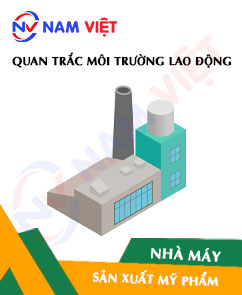
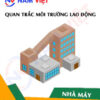
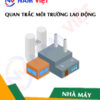
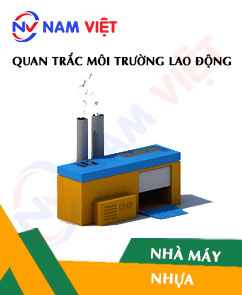

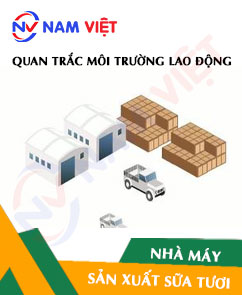





Review Occupational environment monitoring at the factory producing cosmetics
There are no reviews yet.